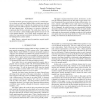Free Online Productivity Tools
i2Speak
i2Symbol
i2OCR
iTex2Img
iWeb2Print
iWeb2Shot
i2Type
iPdf2Split
iPdf2Merge
i2Bopomofo
i2Arabic
i2Style
i2Image
i2PDF
iLatex2Rtf
Sci2ools
ICASSP
2009
IEEE
2009
IEEE
Experimenting with a global decision tree for state clustering in automatic speech recognition systems
In modern automatic speech recognition systems, it is standard practice to cluster several logical hidden Markov model states into one physical, clustered state. Typically, the clustering is done such that logical states from different phones or different states can not share the same clustered state. In this paper, we present a collection of experiments that lift this restriction. The results show that, for Aurora 2 and Aurora 3, much smaller models perform as least as well as the standard baseline. On a TIMIT phone recognition task, we analyze the tying structures introduced, and discuss the implications for building better acoustic models.
Automatic Speech Recognition | ICASSP 2009 | Logical Hidden Markov | Logical States | Signal Processing |
Related Content
| Added | 21 May 2010 |
| Updated | 21 May 2010 |
| Type | Conference |
| Year | 2009 |
| Where | ICASSP |
| Authors | Jasha Droppo, Alex Acero |
Comments (0)

